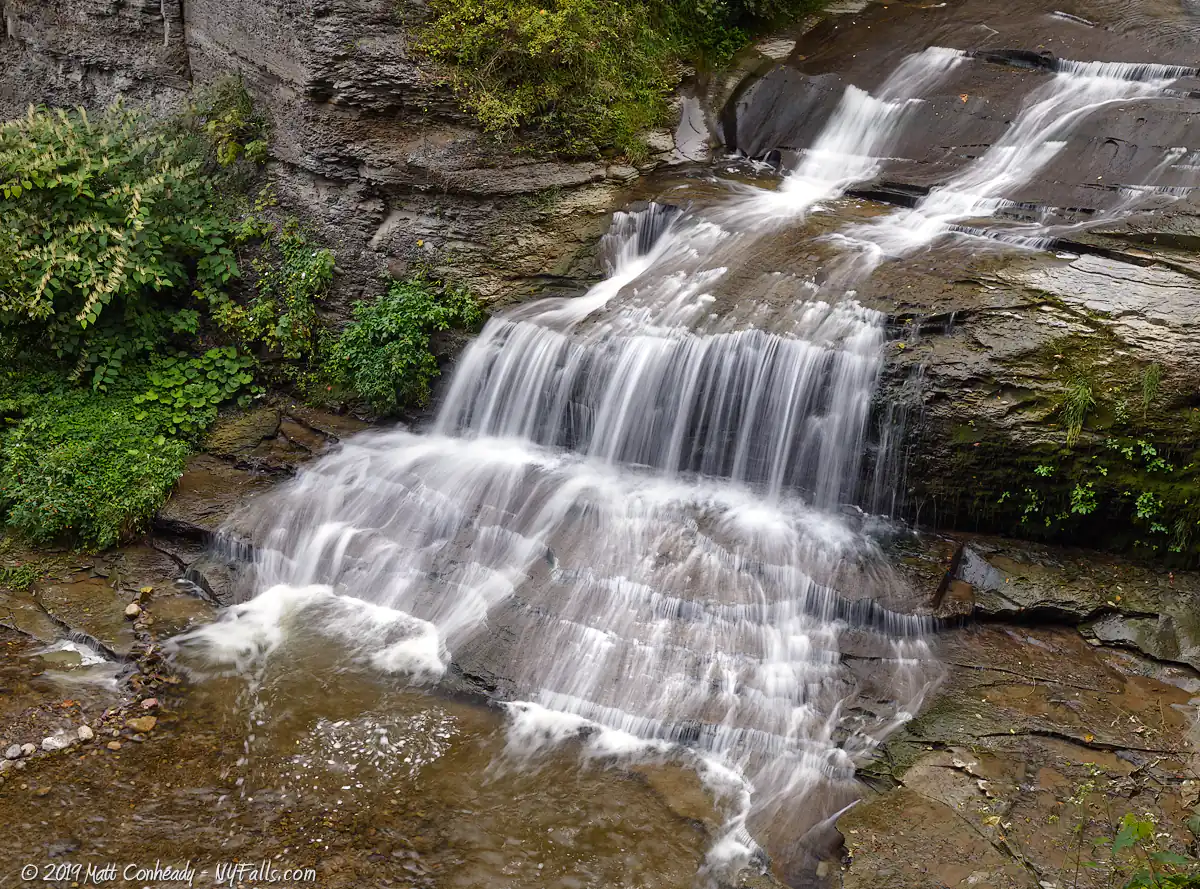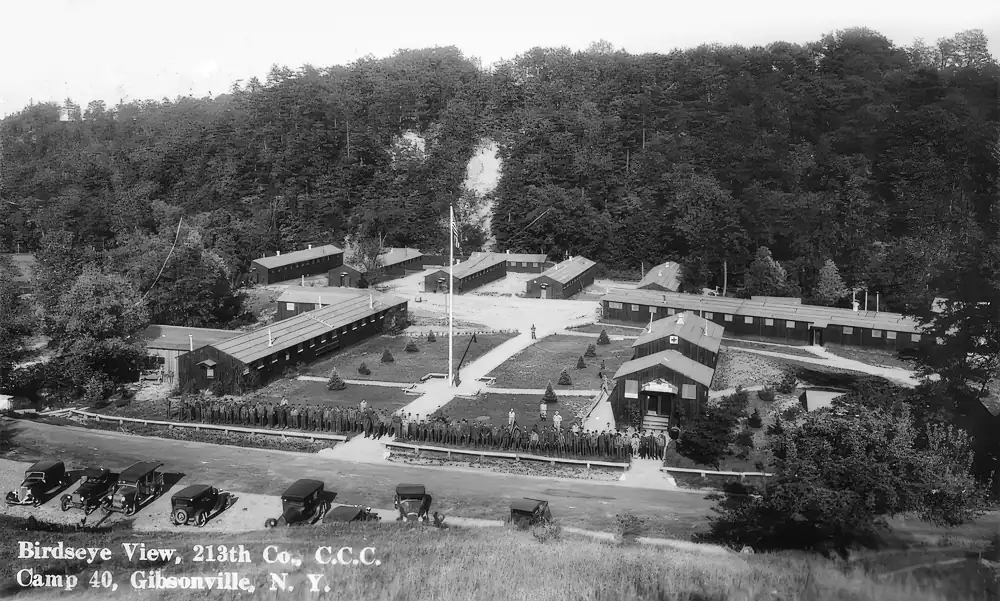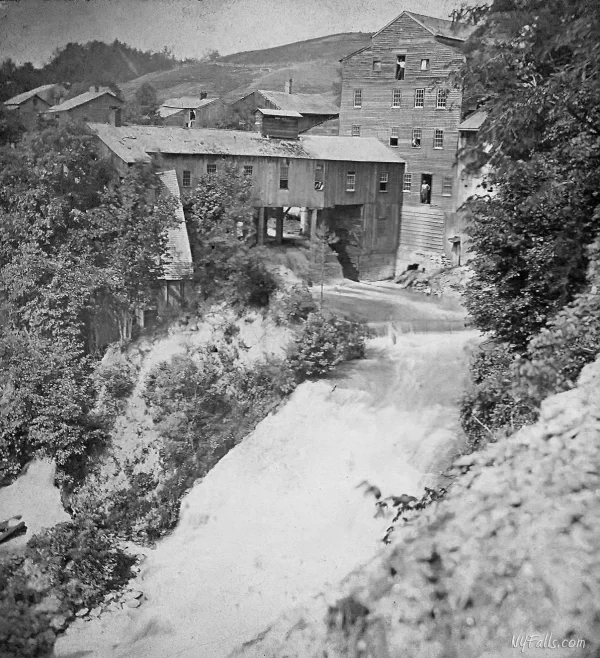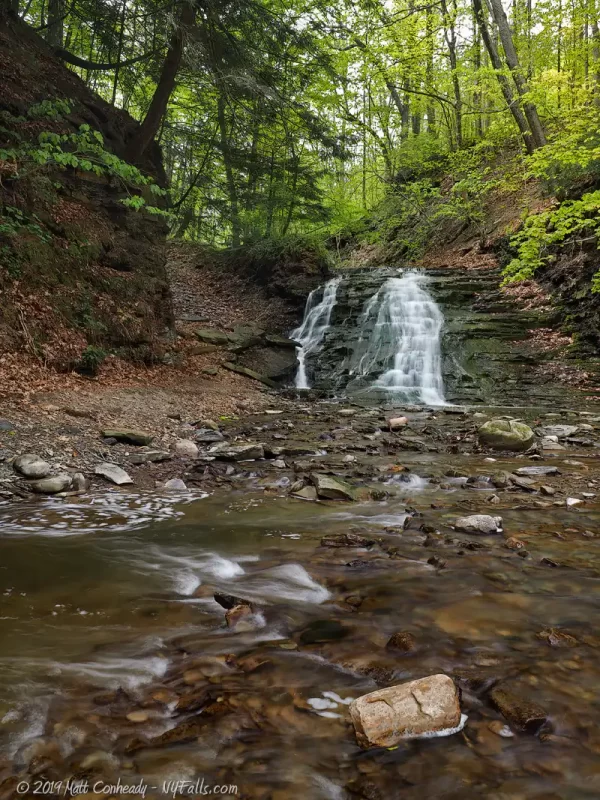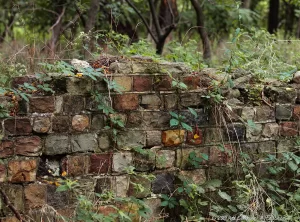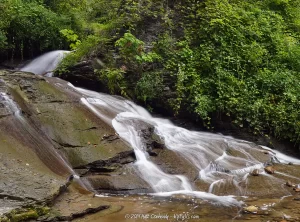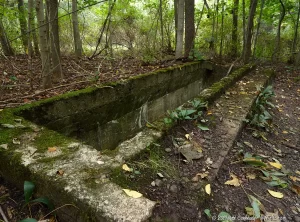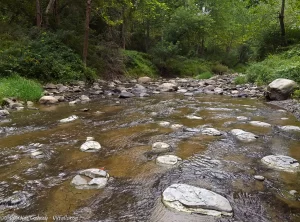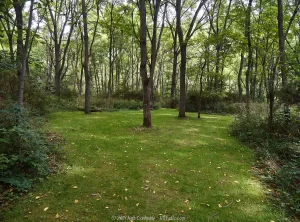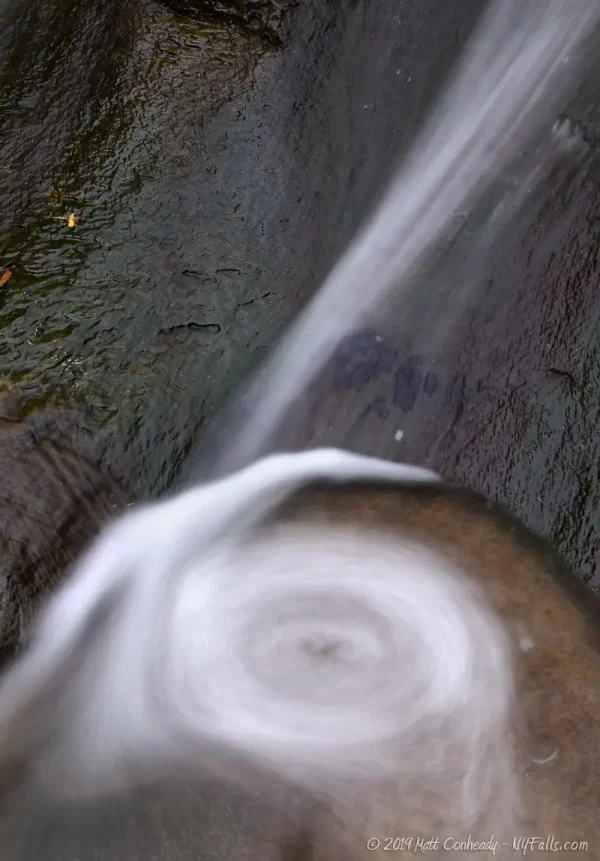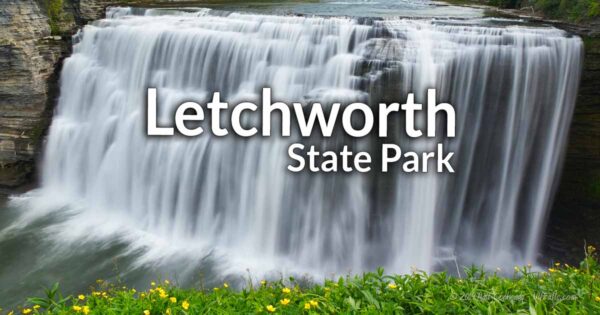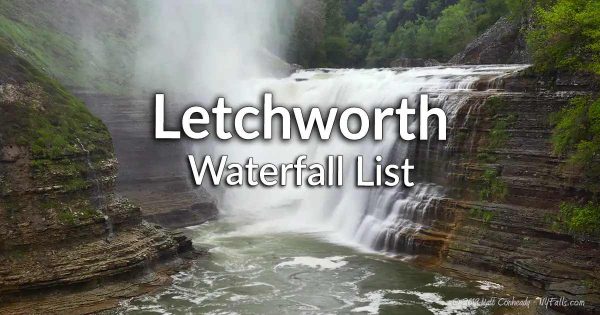Papermill Falls, Letchworth Park

Location: Along the Silver Lake Outlet; in Letchworth State Park, Livingston County, New York.
Maps: Google Map; Bing Maps; Topographic; Trail Map – North Letchworth; State-Park-Map; Interactive map.
GPS Coordinates:
- Parking and Trailhead: N 42.70172 / W 77.93797
- Papermill Falls: N 42.70440 / W 77.93372
- Creek bed entry: N 42.70567 W 77.92983
Directions:
- From Mount Morris, enter Letchworth State Park and head south on the main park road.
- About 3.5 miles in you will see a sign on the right side of the road that indicates the site of “Gibsonville.”
- Slow down and keep an eye on the left for the parking area and trail-head, which will come up in the next half-mile.
Or use Google Maps.
Parking: Park along the road in the gravel patch near the Gibsonville historic sign and trail-head. Space for about 5 cars.

Weather
Information / Accessibility / Accommodations
Number of falls: 2 (including one seasonal waterfall).
Size/Types: Papermill Falls, totaling 45 ft tall (roughly) begins as a gradual cascade that forms into a slight curtain plunge of about 4 ft and then cascades to a large level area. Here the water splits, with an immediate turn south and down a narrow chasm twisting and turning 12 ft down. The rest of the water pools below the top tier and then drops down a wide gradual cascade of about 25 ft in height.
Best time to visit: Spring, summer (after moderate rain), fall.
Flow: Moderate. It is flowing throughout the year.
Waterway: Silver Lake Outlet, which starts out 4.5 miles to the west at Silver Lake, and drops over 750 ft as it makes its way to the Genesee River in Letchworth State Park. The Genesee then runs 40 miles north, through the city of Rochester, towards Lake Ontario.
Time: 30 minutes to get a glimpse. An hour or more to get to the base of the falls.
Seasons/Hours: Open with the Park. Open year-round, daily, from 6am to 11pm.
Admission: $8 vehicle fee to enter Letchworth State Park.
Handicap accessibility: No.
Pets: Allowed if on leash. Due to the danger involved with this trail, we highly recommend not bringing your pets. This is not only for your pet’s safety, but for the safety of fellow hikers. Be smart and safe for your pets! Please clean up after.
Accommodations: Trails; signs; The park itself has several accommodations, but you need to drive north to the Mount Morris Dam or Highbanks Recreation Area, or south to St. Helena picnic area.
Description
AKA: Silver Lake Outlet Falls; Double Drop Falls
One of the lesser-known waterfalls of the cascade-plentiful Letchworth State Park; Papermill Falls often goes undiscovered by most park visitors, most of which head directly to the three main cataracts of the Genesee. Although Papermill Falls is not as easily visible from the gorge rim as are the main waterfalls of the park, all it takes is a brief hike to catch a glimpse. A little venturing out into a side-trail, a quick scramble down into the gorge, and a brief creek-walk will get you access to a wonderfully interesting waterfall that not too many people take the time to see.
The Gibsonville Trail is one that rewards not only with the sights and sounds of this refreshing waterfall, but also offers insight into the pioneer and Great Depression-era history of this location. Although virtually no remnants of the village of Gibsonville can be easily spotted, what can be seen here, crumbling and nearly overgrown, are foundations of the Civilian Conservation Corp camp that operated here in the 1930s. It was the efforts of the CCC, created to provide jobs to thousands of unemployed young men during the Great Depression, that created the distinct carpentry and masonry that characterizes the park, its shelters, barriers and bridges. Without the CCC’s work, the park’s infrastructure would be majorly lacking.
The area of the old village and camp are certainly open to exploration, and a little bushwhacking can lead to a few rarely seen ruins, but the main trail is an easy mowed grass and packed dirt pathway that leads right past the falls and to the Chipmunk Trail. Those who want to reach the base of the falls can work their way down into the gorge and hike up the Silver Lake Outlet to the base.
Papermill Falls begins as a gradual cascade that forms into a slight curtain plunge of about 4 ft and then cascades to a large level area. Here the water splits, with an immediate turn south and down a narrow chasm twisting and turning 12 ft down. The rest of the water pools below the top tier and then drops down a wide gradual cascade of about 25 ft in height. In high flow, the line between the three segments tend to blur, creating a large cataract that wraps around the large limestone and shale pillar that separates the main falls from the chute.
The seclusion of this falls in the park, its historic significance, and odd shape, make it one of the more exciting falls in Upstate New York to visit. The one downside is that the water coming from the weed-ridden Silver Lake, is not very clean.
History
The trail that leads you along the Silver Creek Outlet past the falls and then down to the Genesee River, was once a dirt road lined with several homes and businesses that made up the small village of Gibsonville. It stood here for roughly a century, now long vanished since the early 1900s.
The first settler was Ebenezer “Indian” Allen. The first pioneer to settle in what is now Rochester, he worked for the US government as liaison between settlers and the Indians in the Genesee Valley. An infamous criminal, womanizer (especially with Iroquois ladies, hence the nickname), polygamist, and some would call “traitor,” he is considered to be the region’s first notorious outlaw. He built the first mills on the Genesee in what was to become Rochester, and when his benders and criminal deeds caught up with him, he relocated to the town of Mount Morris and built a saw mill on the Silver Lake Outlet at this very site in 1792.
A year later, Indian Allen and two of his wives relocated to Canada and the saw mill was soon converted to a grist mill, operated by Henry Gibson. In 1840 the grist mill was sold to George H. West, and converted to a paper mill, which processed fabric remnants from the knitting mills in nearby Perry, NY into pulp which was used to produce fine paper.
At its peak, Gibsonville was home to 16 houses, a general store, post office, shoemaker, mill, blacksmith and a primary school. Its decline began when the struggling paper mill burned to the ground in 1894 and was not rebuilt, crippling the economy, which never recovered and eventually succumbed to the Great Depression. Eventually the village of Mount Morris enveloped the remaining population. Gibsonville was completely abandoned by the time the land officially became a part of Letchworth State Park.
People once again inhabited the site of Gibsonville beginning in 1933 when the public works venture, the Civilian Conservation Corps, occupied a large camp there. The CCC built many of the stone barriers, pavilions, shelters, bridges and blazed trails that characterize the look and feel of many of the parks in the region. It was this massive effort that transformed Letchworth State Park into the accessible and world-class attraction that it is today.
One of four CCC camps in the park, the SP 17 Gibsonville Camp constructed shelters, fireplaces, rail fences, comfort stations, and the main park road from Mt. Morris to the Wolf Creek. They also constructed trails, planted seeds, cleaned up dead trees and brush, and operated two stone quarries within the park. It is said that when CCC workers at this camp were off the clock, they enjoyed sliding down and bathing in the refreshing waters of the falls. The CCC public works program for Letchworth State Park ended in 1941. All that exists of the camp today is a stone chimney from the officers’ barracks, several foundations of various structures, and a former camp building that now houses the camping supervisor in the Highbanks campgrounds to the south.
Hiking / Walking Trails
Difficulty: Variable. It may be slippery in winter or after heavy rain. Use caution.
Markings: Park signs and colored blazes.
Distance: The park has tens of miles of trails, more than can be hiked in a single day. To walk to the 3 main falls, you are looking at about a 1.8 mile trek from the Upper Falls to the Lower Falls.
Trail Guide: There are two types of trails in Letchworth State Park. The majority of the trails are wide, lined with stone or sufficiently cleared. Steps are generally stonework and well-kept. Some trails are even paved. The less beaten pathways are narrow, lined with dirt, rocks and branches. Many trails traverse down into the gorge and you must know the water levels and weather forecast (ask any park ranger or police, or in the visitor center) before hiking down into the gorge.
The trails in Letchworth State Park are so numerous, it is recommended that you invest in a detailed trail guide, which can be found at the visitor center. You may also obtain a Finger Lakes Trail map from the Finger Lakes Trail Conference. Trails range from a half-mile (the Portage Trail 6) to 24 miles in length (The Finger Lakes Trail -FLT).
Although one would expect the more mainstream trails to be safer than the lesser used ones, as a matter-of-fact even the most well-kept trails should be used with caution. In 2006, a portion of the gorge trail at the crest of Middle Falls fell over the edge due to erosion. This is a well-kept, paved area, often used as an overlook to the Middle Falls. Luckily no one was hurt. If bringing small children, keep in mind that a lot of these trails are strenuous, involving slippery surfaces, steep slopes, and many stone steps not ideal for children.
Map: Trail Map – North Letchworth; State-Park-Map; Interactive map.
Gibsonville Trail and Papermill Falls Interactive Map
Letchworth Papermill Falls Media
Interesting Stuff
CCC Camp Clues
The Civilian Conservation Camp that was built here in 1933, was laid out like a military barracks with several workers’ quarters set in rows, surrounding a central courtyard. An officer’s barracks and mess hall were located at the head of the camp. The cement foundations of the quarters still exist as do cement pits used to house waste oil and water. A crude well, now filled in, was also constructed for the camp. A chimney from the officers’ barracks is all that remains of that particular structure.
Gibsonville bearings
Where the Gibsonville trail meets with the Chipmunk Trail (which heads uphill) is the location where the pioneer village’s general store/post office building was located. This was the northern-most structure in the village.
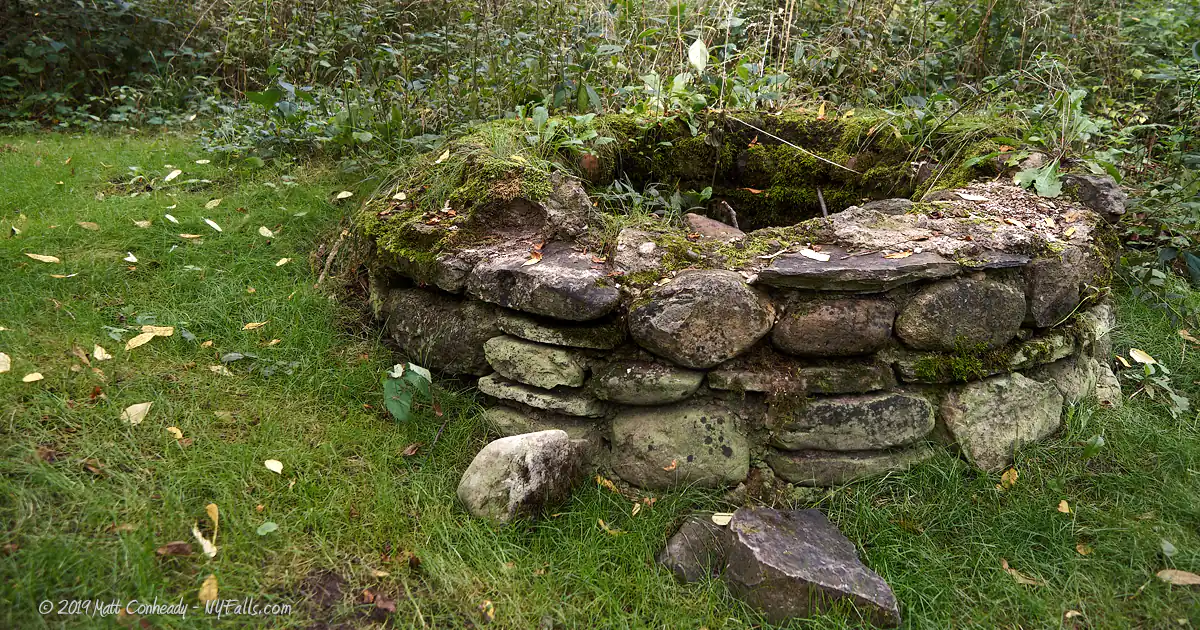
Photography Tips
Getting it all
- We just could not find a way to fit the whole falls (all three sections) into one frame. The best vantage point was from the trail above, but the view was too obstructed by trees to get a decent shot. You may have better luck when the leaves have fallen. Even then, the chute is mostly obscured by rock.
The creek
- Don’t just concentrate on the waterfalls, there are plenty of small drops, twists in the creek, interesting stones and trees along the way.
Explore a bit off the trail
- Be careful around the gorge, but feel free to wander a bit off the trail. See if you can spot any signs of the camp or the village.
Mist
- Be mindful of mist when shooting from the viewing platform on the eastern side. Bring a soft but absorbent lens cleaning cloth and wipe your lens frequently.
Silky water effect
- To get that smooth cotton-candy look to the falls, you need to use a Neutral Density (ND) filter on your lens. The ND filter will block some of the light from entering the lens without altering the color, and thus allow your shutter to stay open longer. This blurs the water and creates a soft white gloss to the foamy areas of the falls. Check out the article for the all the details.
More tips
- See the Articles for more photography tips.
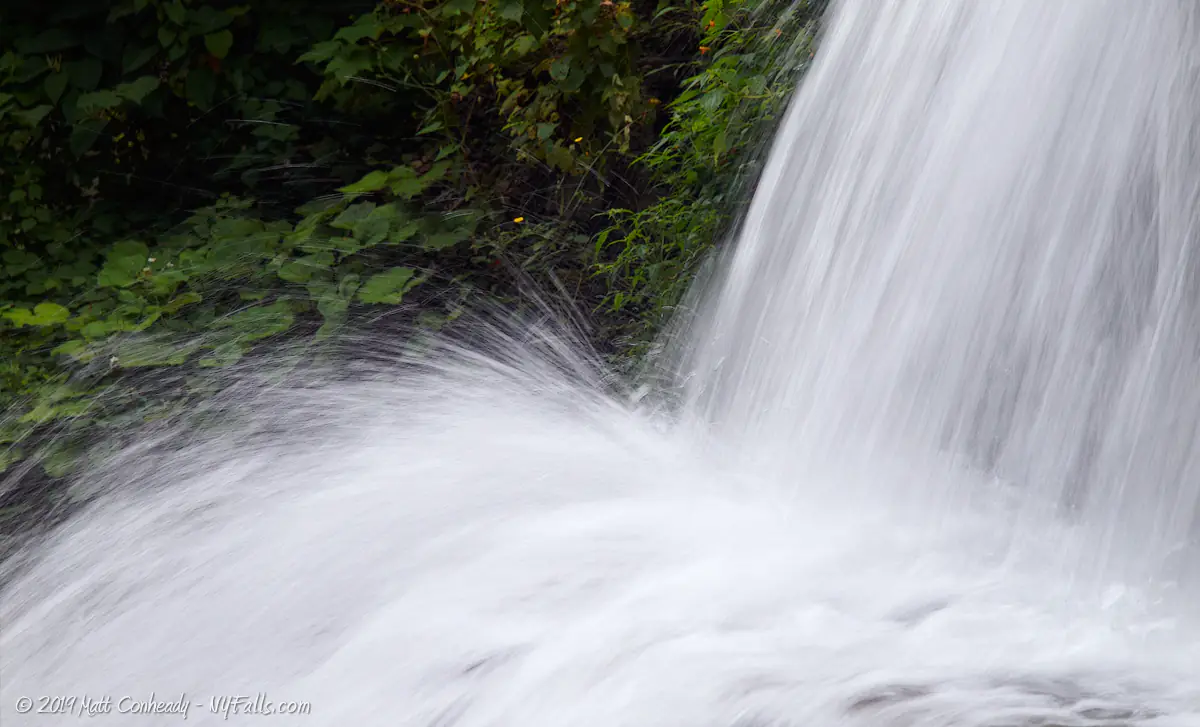
Other Letchworth Pages
Letchworth State Park
An overview of Letchworth and its many natural features and state park amenities.
All the Waterfalls in the park and where to find them
Letchworth State park has dozens of waterfalls along its many tributaries. Some can only be seen after heavy rain. Others just require you to cross to the other side of the gorge.
Where to Stay
Descriptions of the camping and lodging options available in the park. From the luxurious and historic Glen Iris Inn to the forested campsites around the park.
Who to Contact
Letchworth State Park
1 Letchworth State Park
Castile, NY 14427
Visitor Center: (585) 493-3600
NYS Park Police: (585) 658-4692
The Glen Iris Inn: (585) 493-2622
Campground: (585) 237-3303




